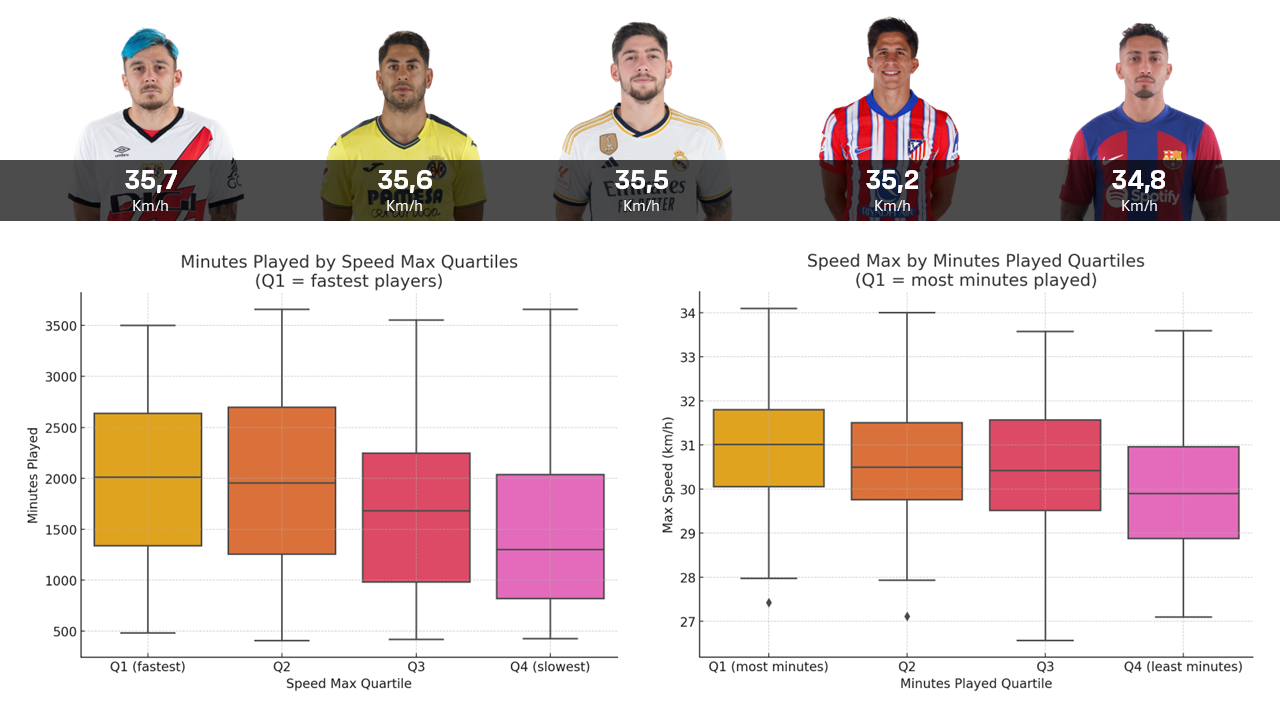
09 May Do the fastest players play more… or do those who play more just happen to be faster?
However you look at it, the fastest players tend to play more minutes in LALIGA
Picture this: you’re preparing for a decisive match. Two players are available for the same role, both tactically reliable. But one of them has something special—when he accelerates, he can break lines or recover position in a flash. Do you pick him? Most coaches would. And the data suggests you’d be making the right choice.
During the 2023/24 LALIGA EA Sports season, maximum in-game speeds were recorded for over 500 professional players. We used that data to rigorously test a question that seems simple, yet has major implications for team selection and load management:
Is there a relationship between a player’s top speed and the minutes they play?
The short answer is yes. But don’t stop there—the full story reveals much more.
Two approaches. One consistent finding.
To ensure reliability, we looked at the question from two angles:
- First, we grouped players by their maximum sprint speed during official matches (split into quartiles).
- Then, we flipped the analysis: we grouped players by total minutes played, and checked whether those who played the most were also faster.
The outcome was the same in both cases.
The fastest players play more. And the ones who play more are usually faster.
In the first approach, players in the highest top-speed quartile (above 31.5 km/h) played an average of 1981 minutes over the season. Those in the slowest group? Just 1483 minutes.
That’s a gap of nearly 500 minutes—over five full matches—and the difference is statistically significant (p = 0.0073).
In the second approach, the relationship was even clearer:
The players with the most minutes (above 2636) had an average max speed of 30.91 km/h, while those with the fewest minutes didn’t go beyond 29.97 km/h.
Once again, the difference was statistically significant (p < 0.0001).
The key takeaway isn’t just that the relationship exists, but that it holds regardless of which variable you start from.
Does it vary by position? That’s where it gets interesting.
When we broke down the data by position, we found the trend was stronger in certain roles:
- Among fullbacks, central midfielders, and wide midfielders, top speed was strongly linked to more minutes on the pitch.
- In centre-backs and forwards, however, the relationship wasn’t statistically significant.
In short: it’s not about running for the sake of it. In roles where high-intensity movement matters most, top-end speed can be a key competitive asset—for recovering space, exploiting gaps, or adjusting to transitions.
What can coaches do with this information?
These findings aren’t just academically interesting—they have direct applications to training and squad management:
- Individualised physical planning: If you have a wide player who doesn’t reach competitive sprint thresholds, you might focus part of their programme on speed development. It could directly increase their chances of playing.
- Selection and rotation decisions: In high-demand fixtures, top speed in match conditions is a useful, objective indicator when choosing between players.
- Talent identification: In youth development or scouting, a player who can already hit competitive sprint speeds in their position is more likely to succeed at the professional level.
- Early warning signs of fatigue or underperformance: If a typically fast player starts showing significantly lower top speeds, this could be an early flag for overtraining, fatigue, or injury risk. Speed is not just a physical attribute—it’s a form marker.
Thinking in terms of competitive value
Top speed won’t replace passing, positioning or tactical awareness. But in today’s football, speed increases advantage, reduces error, and expands a player’s capacity to impact key moments.
And as the full-season data from LALIGA shows, it’s one of the clearest traits linked to consistent playing time.
Final thought: top speed as a functional performance indicator
Here’s a simple takeaway:
Top speed won’t guarantee a starting spot, but having it gets you a lot closer.
And in a context where every training and match decision is increasingly driven by data, this often-overlooked metric deserves more attention.
Keywords:


